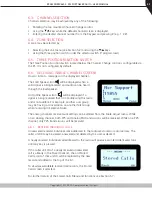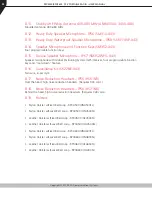
Copyright © 2015 RCA Communications Systems
RPX4500/RPX4600 P25 PORTABLE RADIO – USER MANUAL
43
6.3. CHANNEL SELECTION
Channels selection may be achieved by any of the following:
• Rotating the top mounted Channel Change control.
• Using the / keys while the default channel screen is displayed.
• Entering the desired channel number from the Keypad and pressing # (e.g. 1 2 #).
6.4. ZONE SELECTION
A zone may be selected by:
• Selecting the Zone menu (see Section 5.2) and using the / keys.
• Using the three position switch under the selector switch (if programmed).
6.5. THREE POSITION FUNCTION SWITCH
The Three Position Function Switch located below the Channel Change control is configurable via
the PS. It is not configured by default.
6.6. RECEIVING (SINGLE CHANNEL SCREEN)
How to listen to messages on the displayed channel -
The Solid Speaker Icon
will be displayed when a
valid signal is being received and audio can be heard
through the loudspeaker.
An Outline Speaker Icon
will be displayed if a
signal is being received that is not addressing this radio
and is not audible. For example, another user group
may be having a conversation on another Talk Group
when receiving in Selective Mute.
The analog channel’s receive mute setting can be altered from the Mute Adjust menu. While
on an Analog channel, both P25 and Analog FM transmissions will be received. While on a P25
channel, only P25 transmissions will be received.
6.6.1. RECEIVED INDIVIDUAL CALLS
Unanswered received individual calls addressed to the radio are stored in radio memory. The
caller unit ID may be viewed, answered and deleted by the user as desired.
A newly received individual call addressed to the radio will produce an intermittent alert tone
until any key is pressed.
If the caller unit ID of a newly received unanswered
call is already in the Stored Calls list, the old Stored
Call record of that unit ID will be replaced by the new
record and added to the top of the list.
To view/answer/delete received call records, the Stored
Calls screen is selected.
For further details of the Stored Calls Menu and functions see Section 5.7.






























